engine JEEP WRANGLER 2012 JK / 3.G User Guide
[x] Cancel search | Manufacturer: JEEP, Model Year: 2012, Model line: WRANGLER, Model: JEEP WRANGLER 2012 JK / 3.GPages: 124, PDF Size: 5.48 MB
Page 3 of 124
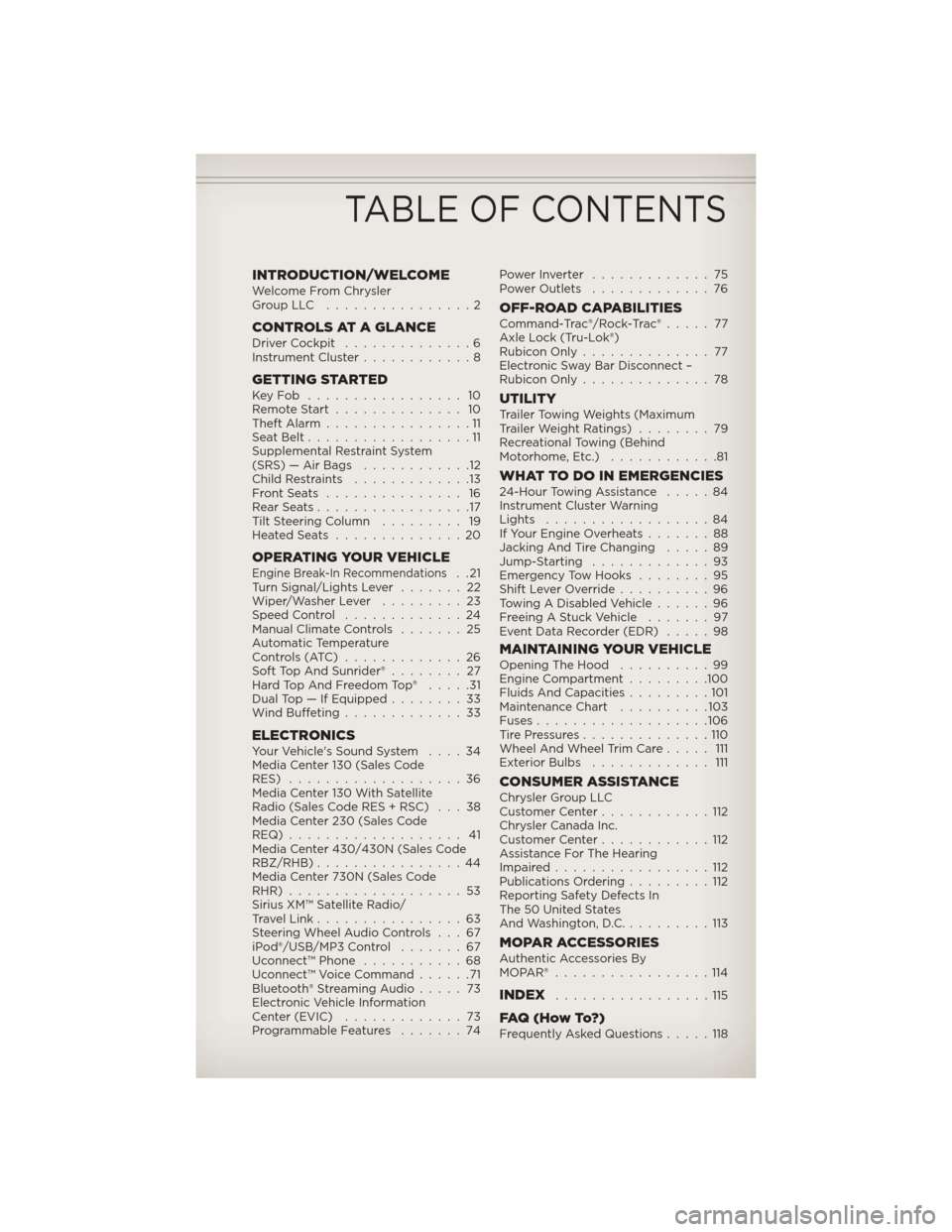
INTRODUCTION/WELCOMEWelcome From Chrysler
GroupLLC ................2
CONTROLS AT A GLANCEDriver Cockpit..............6
Instrument Cluster............8
GETTING STARTEDKeyFob ................. 10
Remote Start.............. 10
Theft Alarm................11
Seat Belt..................11
Supplemental Restraint System
(SRS) — Air Bags............12
Child Restraints.............13
FrontSeats ............... 16
RearSeats.................17
Tilt Steering Column......... 19
HeatedSeats ..............20
OPERATING YOUR VEHICLEEngine Break-In Recommendations..21
Turn Signal/Lights Lever.......22
Wiper/Washer Lever.........23
Speed Control.............24
Manual Climate Controls.......25
Automatic Temperature
Controls (ATC).............26
Soft Top And Sunrider®........ 27
Hard Top And Freedom Top®.....31
Dual Top — If Equipped........33
Wind Buffeting.............33
ELECTRONICSYour Vehicle's Sound System....34
Media Center 130 (Sales Code
RES)...................36
Media Center 130 With Satellite
Radio (Sales Code RES + RSC) . . . 38
Media Center 230 (Sales Code
REQ)................... 41
Media Center 430/430N (Sales Code
RBZ/RHB)................44
Media Center 730N (Sales Code
RHR)...................53
Sirius XM™ Satellite Radio/
Travel Link................63
Steering Wheel Audio Controls . . . 67
iPod®/USB/MP3 Control.......67
Uconnect™ Phone...........68
Uconnect™ Voice Command......71
Bluetooth® Streaming Audio.....73
Electronic Vehicle Information
Center (EVIC).............73
Programmable Features.......74PowerInverter .............75
Power Outlets.............76
OFF-ROAD CAPABILITIESCommand-Trac®/Rock-Trac®..... 77
Axle Lock (Tru-Lok®)
Rubicon Only.............. 77
Electronic Sway Bar Disconnect –
Rubicon Only..............78
UTILITYTrailer Towing Weights (Maximum
Trailer Weight Ratings)........79
Recreational Towing (Behind
Motorhome, Etc.)............81
WHAT TO DO IN EMERGENCIES24-Hour Towing Assistance.....84
Instrument Cluster Warning
Lights..................84
If Your Engine Overheats.......88
Jacking And Tire Changing.....89
Jump-Starting.............93
Emergency Tow Hooks........95
Shift Lever Override..........96
Towing A Disabled Vehicle......96
Freeing A Stuck Vehicle.......97
Event Data Recorder (EDR).....98
MAINTAINING YOUR VEHICLEOpening The Hood..........99
Engine Compartment.........100
Fluids And Capacities.........101
Maintenance Chart..........103
Fuses...................106
TirePressures..............110
Wheel And Wheel Trim Care..... 111
Exterior Bulbs............. 111
CONSUMER ASSISTANCEChrysler Group LLC
Customer Center............112
Chrysler Canada Inc.
Customer Center............112
Assistance For The Hearing
Impaired.................112
Publications Ordering.........112
Reporting Safety Defects In
The 50 United States
And Washington, D.C..........113
MOPAR ACCESSORIESAuthentic Accessories By
MOPAR®.................114
INDEX.................115
FAQ(HowTo?)Frequently Asked Questions.....118
TABLE OF CONTENTS
Page 10 of 124
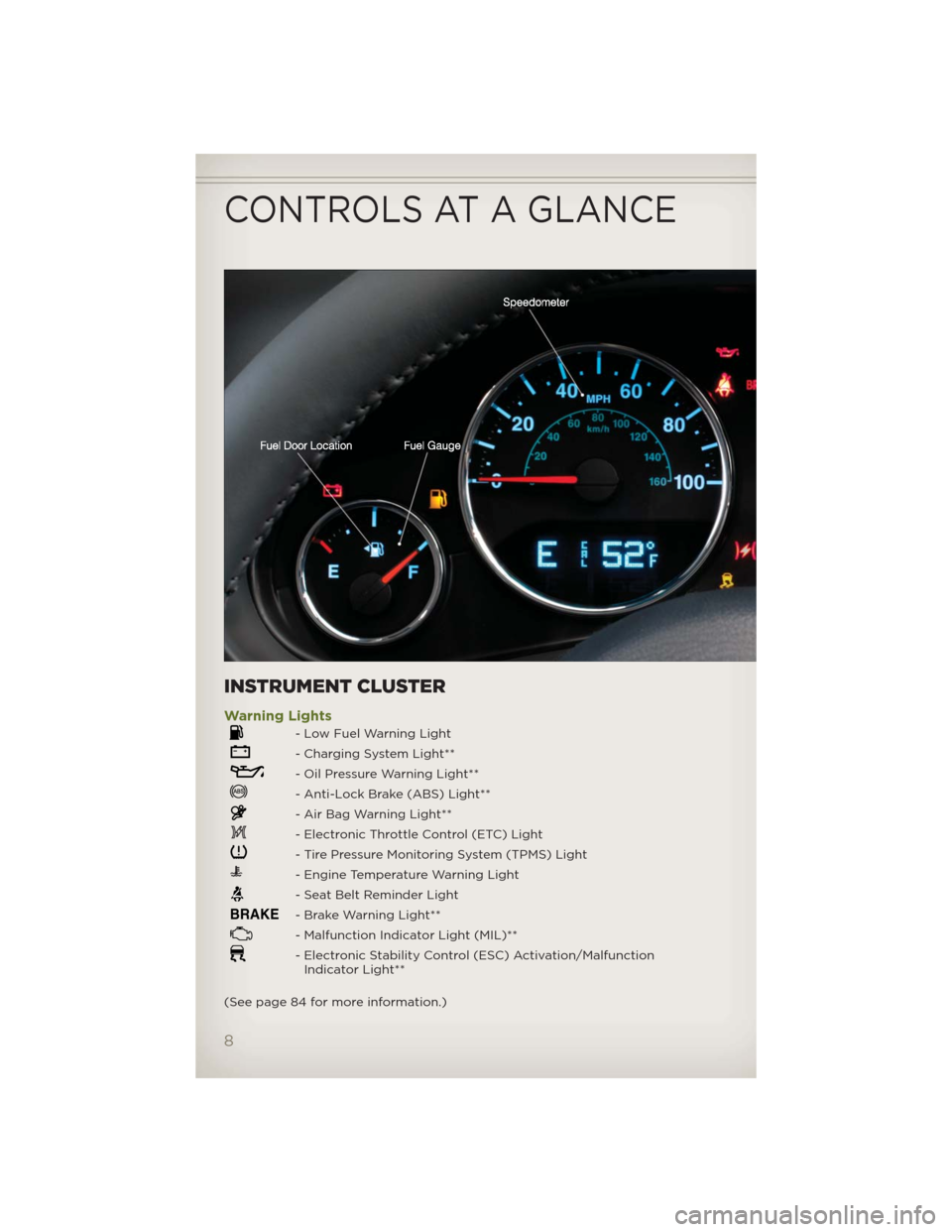
INSTRUMENT CLUSTER
Warning Lights
- Low Fuel Warning Light
- Charging System Light**
- Oil Pressure Warning Light**
- Anti-Lock Brake (ABS) Light**
- Air Bag Warning Light**
- Electronic Throttle Control (ETC) Light
- Tire Pressure Monitoring System (TPMS) Light
- Engine Temperature Warning Light
- Seat Belt Reminder Light
BRAKE- Brake Warning Light**
- Malfunction Indicator Light (MIL)**
- Electronic Stability Control (ESC) Activation/Malfunction
Indicator Light**
(See page 84 for more information.)
CONTROLS AT A GLANCE
8
Page 11 of 124
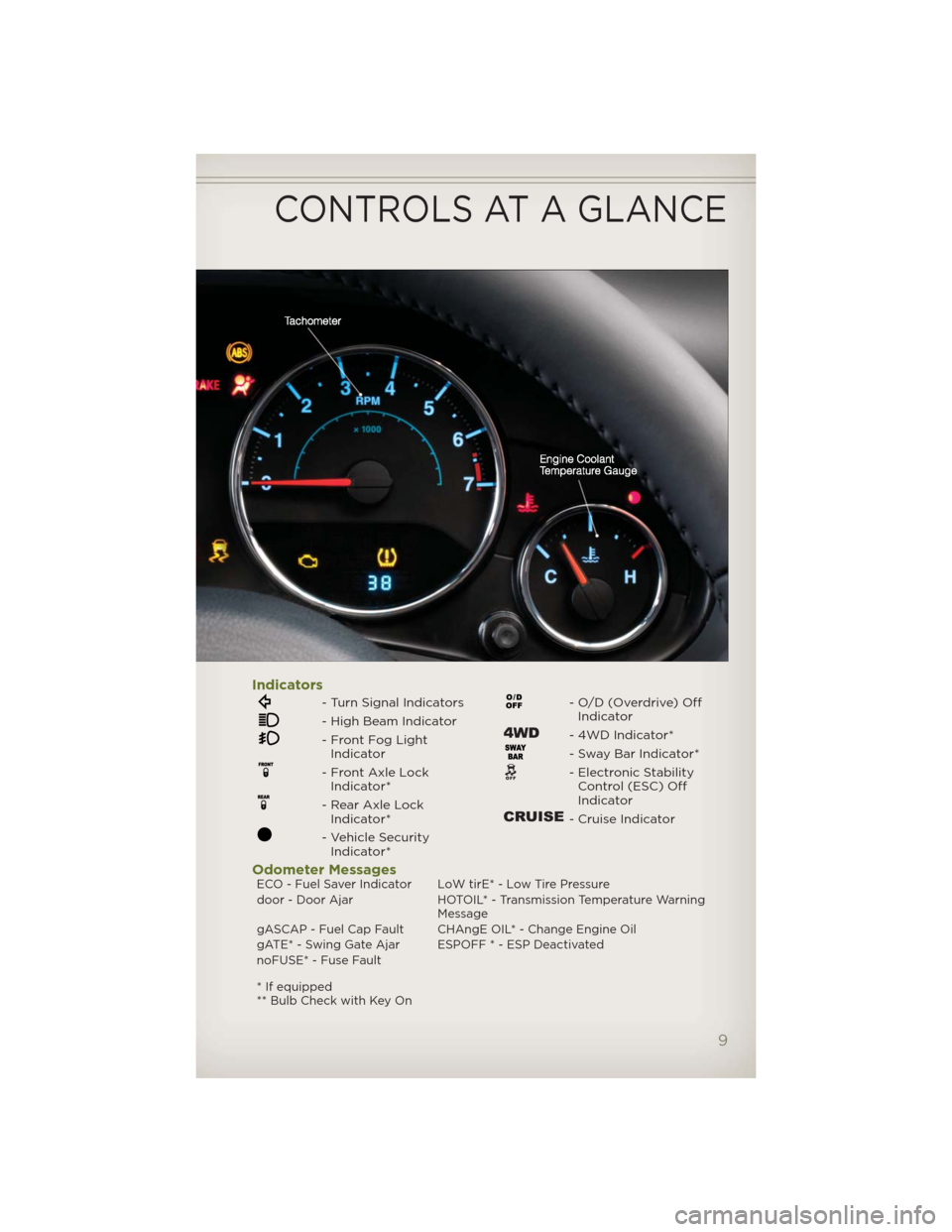
Indicators
- Turn Signal Indicators
- High Beam Indicator
- Front Fog Light
Indicator
- Front Axle Lock
Indicator*
- Rear Axle Lock
Indicator*
- Vehicle Security
Indicator*
- O/D (Overdrive) Off
Indicator
- 4WD Indicator*
- Sway Bar Indicator*
- Electronic Stability
Control (ESC) Off
Indicator
- Cruise Indicator
Odometer MessagesECO - Fuel Saver Indicator LoW tirE* - Low Tire Pressure
door - Door Ajar HOTOIL* - Transmission Temperature Warning
Message
gASCAP - Fuel Cap Fault CHAngE OIL* - Change Engine Oil
gATE* - Swing Gate Ajar ESPOFF * - ESP Deactivated
noFUSE* - Fuse Fault
* If equipped
** Bulb Check with Key On
CONTROLS AT A GLANCE
9
Page 12 of 124
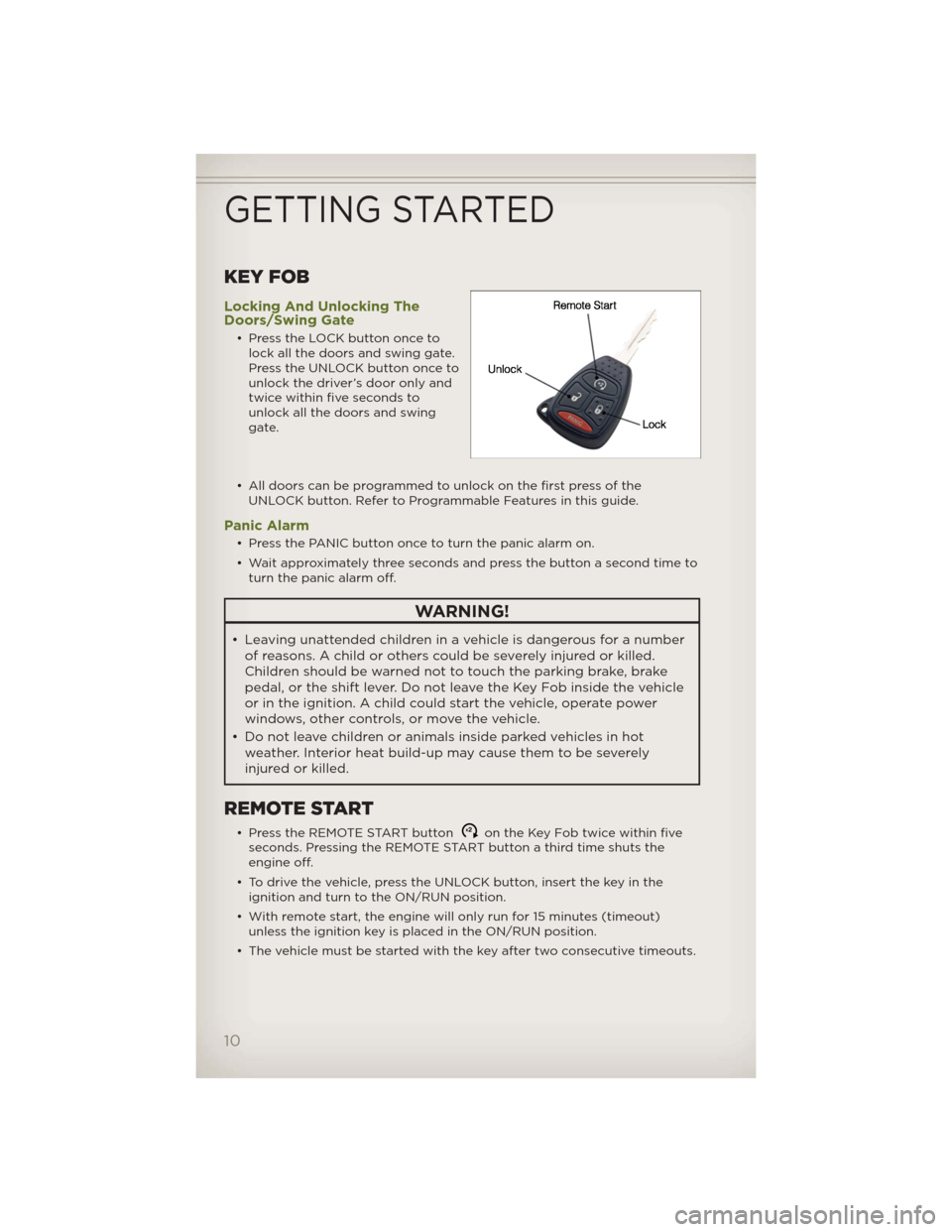
KEY FOB
Locking And Unlocking The
Doors/Swing Gate
• Press the LOCK button once to
lock all the doors and swing gate.
Press the UNLOCK button once to
unlock the driver’s door only and
twice within five seconds to
unlock all the doors and swing
gate.
• All doors can be programmed to unlock on the first press of the
UNLOCK button. Refer to Programmable Features in this guide.
Panic Alarm
• Press the PANIC button once to turn the panic alarm on.
• Wait approximately three seconds and press the button a second time to
turn the panic alarm off.
WARNING!
• Leaving unattended children in a vehicle is dangerous for a number
of reasons. A child or others could be severely injured or killed.
Children should be warned not to touch the parking brake, brake
pedal, or the shift lever. Do not leave the Key Fob inside the vehicle
or in the ignition. A child could start the vehicle, operate power
windows, other controls, or move the vehicle.
• Do not leave children or animals inside parked vehicles in hot
weather. Interior heat build-up may cause them to be severely
injured or killed.
REMOTE START
• Press the REMOTE START buttonx2on the Key Fob twice within five
seconds. Pressing the REMOTE START button a third time shuts the
engine off.
• To drive the vehicle, press the UNLOCK button, insert the key in the
ignition and turn to the ON/RUN position.
• With remote start, the engine will only run for 15 minutes (timeout)
unless the ignition key is placed in the ON/RUN position.
• The vehicle must be started with the key after two consecutive timeouts.
GETTING STARTED
10
Page 13 of 124
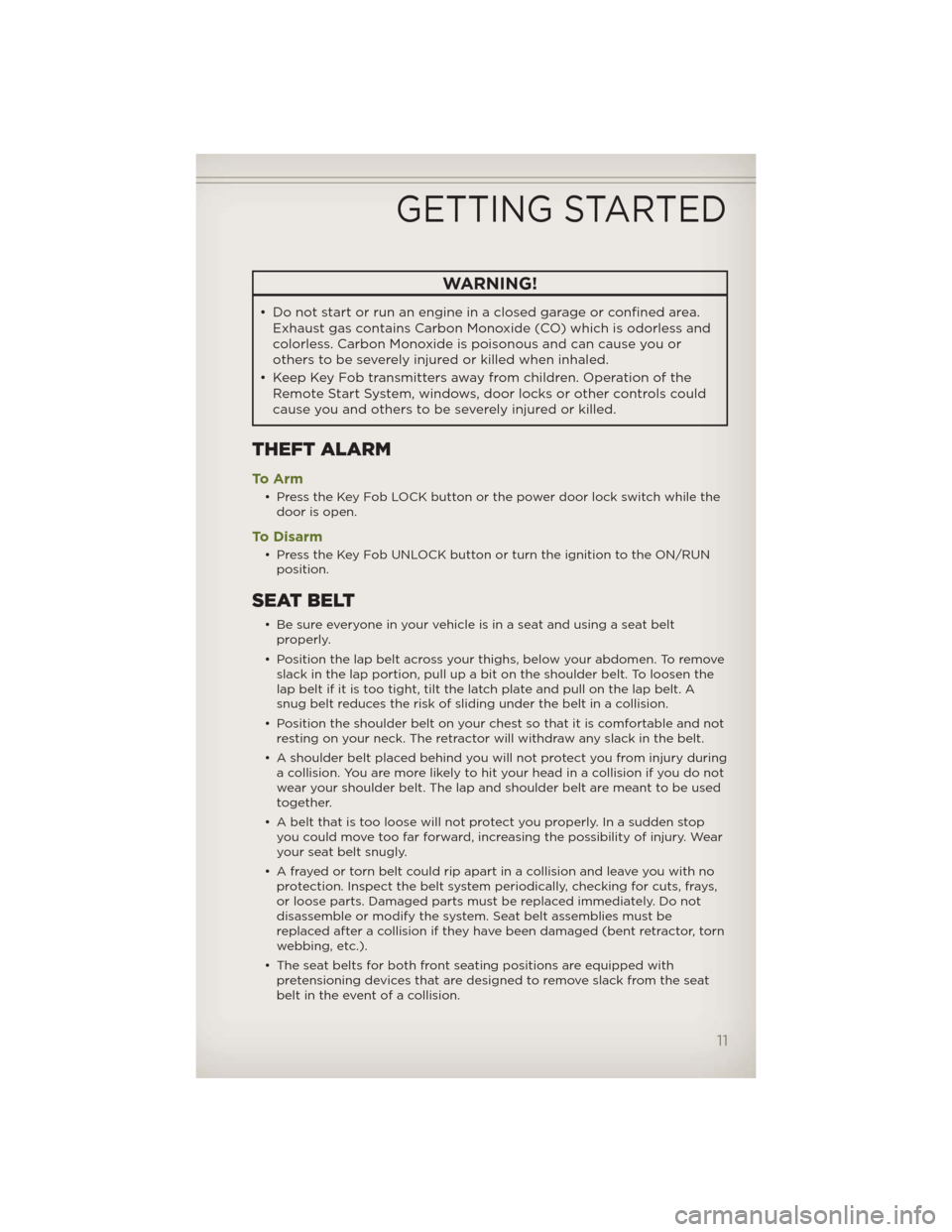
WARNING!
• Do not start or run an engine in a closed garage or confined area.
Exhaust gas contains Carbon Monoxide (CO) which is odorless and
colorless. Carbon Monoxide is poisonous and can cause you or
others to be severely injured or killed when inhaled.
• Keep Key Fob transmittersaway fromchildren. Operation of the
Remote Start System, windows, door locks or other controls could
cause you and others to be severely injured or killed.
THEFT ALARM
To A r m
• Press the Key Fob LOCK button or the power door lock switch while the
door is open.
To Disarm
• Press the Key Fob UNLOCK button or turn the ignition to the ON/RUN
position.
SEAT BELT
• Be sure everyone in your vehicle is in a seat and using a seat belt
properly.
• Position the lap belt across your thighs, below your abdomen. To remove
slack in the lap portion, pull up a bit on the shoulder belt. To loosen the
lap belt if it is too tight, tilt the latch plate and pull on the lap belt. A
snug belt reduces the risk of sliding under the belt in a collision.
• Position the shoulder belt on your chest so that it is comfortable and not
resting on your neck. The retractor will withdraw any slack in the belt.
• A shoulder belt placed behind you will not protect you from injury during
a collision. You are more likely to hit your head in a collision if you do not
wear your shoulder belt. The lap and shoulder belt are meant to be used
together.
• A belt that is too loose will not protect you properly. In a sudden stop
you could move too far forward, increasing the possibility of injury. Wear
your seat belt snugly.
• A frayed or torn belt could rip apart in a collision and leave you with no
protection. Inspect the belt system periodically, checking for cuts, frays,
or loose parts. Damaged parts must be replaced immediately. Do not
disassemble or modify the system. Seat belt assemblies must be
replaced after a collision if they have been damaged (bent retractor, torn
webbing, etc.).
• The seat belts for both front seating positions are equipped with
pretensioning devices that are designed to remove slack from the seat
belt in the event of a collision.
GETTING STARTED
11
Page 23 of 124
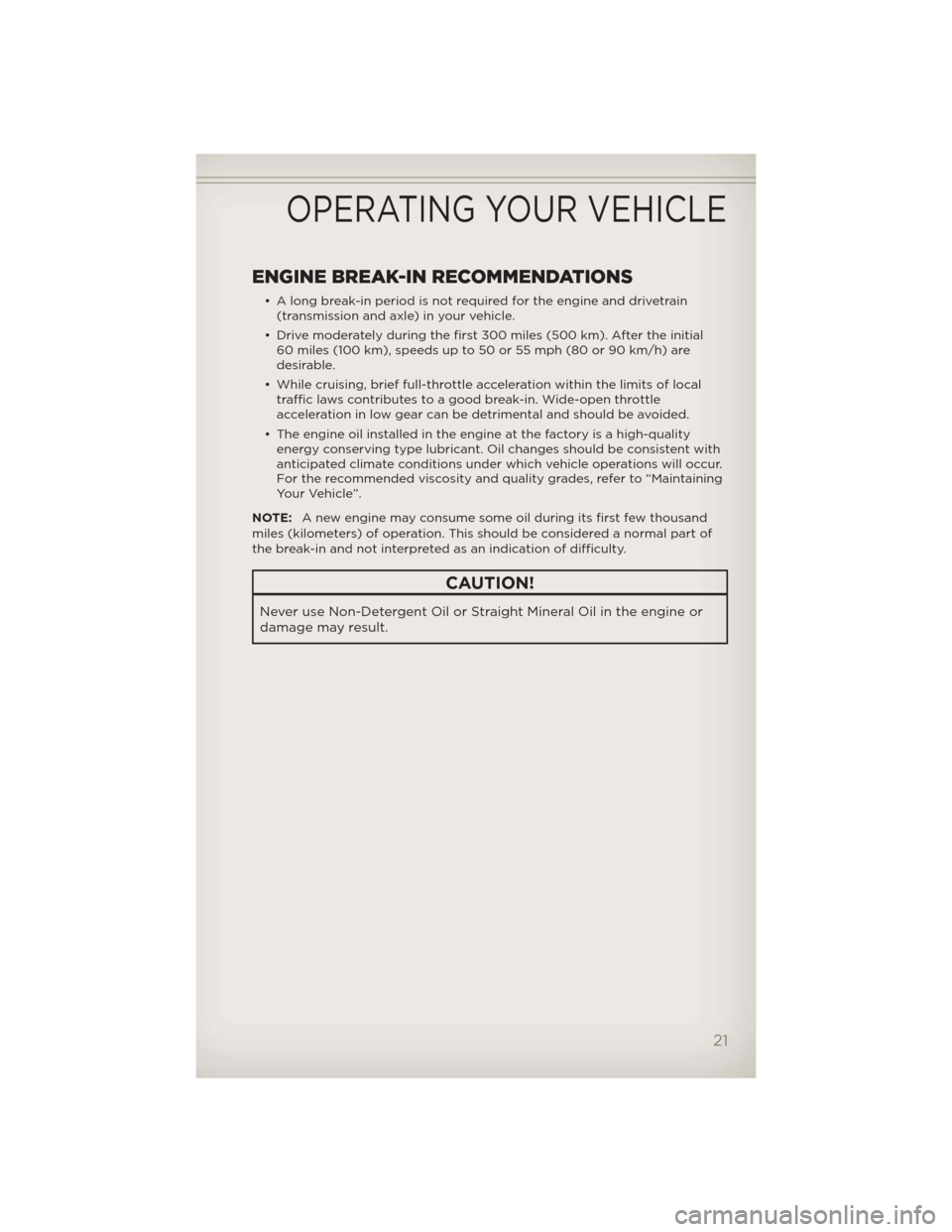
ENGINE BREAK-IN RECOMMENDATIONS
• A long break-in period is not required for the engine and drivetrain
(transmission and axle) in your vehicle.
• Drive moderately during the first 300 miles (500 km). After the initial
60 miles (100 km), speeds up to 50 or 55 mph (80 or 90 km/h) are
desirable.
• While cruising, brief full-throttle acceleration within the limits of local
traffic laws contributes to a good break-in. Wide-open throttle
acceleration in low gear can be detrimental and should be avoided.
• The engine oil installed in the engine at the factory is a high-quality
energy conserving type lubricant. Oil changes should be consistent with
anticipated climate conditions under which vehicle operations will occur.
For the recommended viscosity and quality grades, refer to “Maintaining
Your Vehicle”.
NOTE:A new engine may consume some oil during its first few thousand
miles (kilometers) of operation. This should be considered a normal part of
the break-in and not interpreted as an indication of difficulty.
CAUTION!
Never use Non-Detergent Oil or Straight Mineral Oil in the engine or
damage may result.
OPERATING YOUR VEHICLE
21
Page 81 of 124
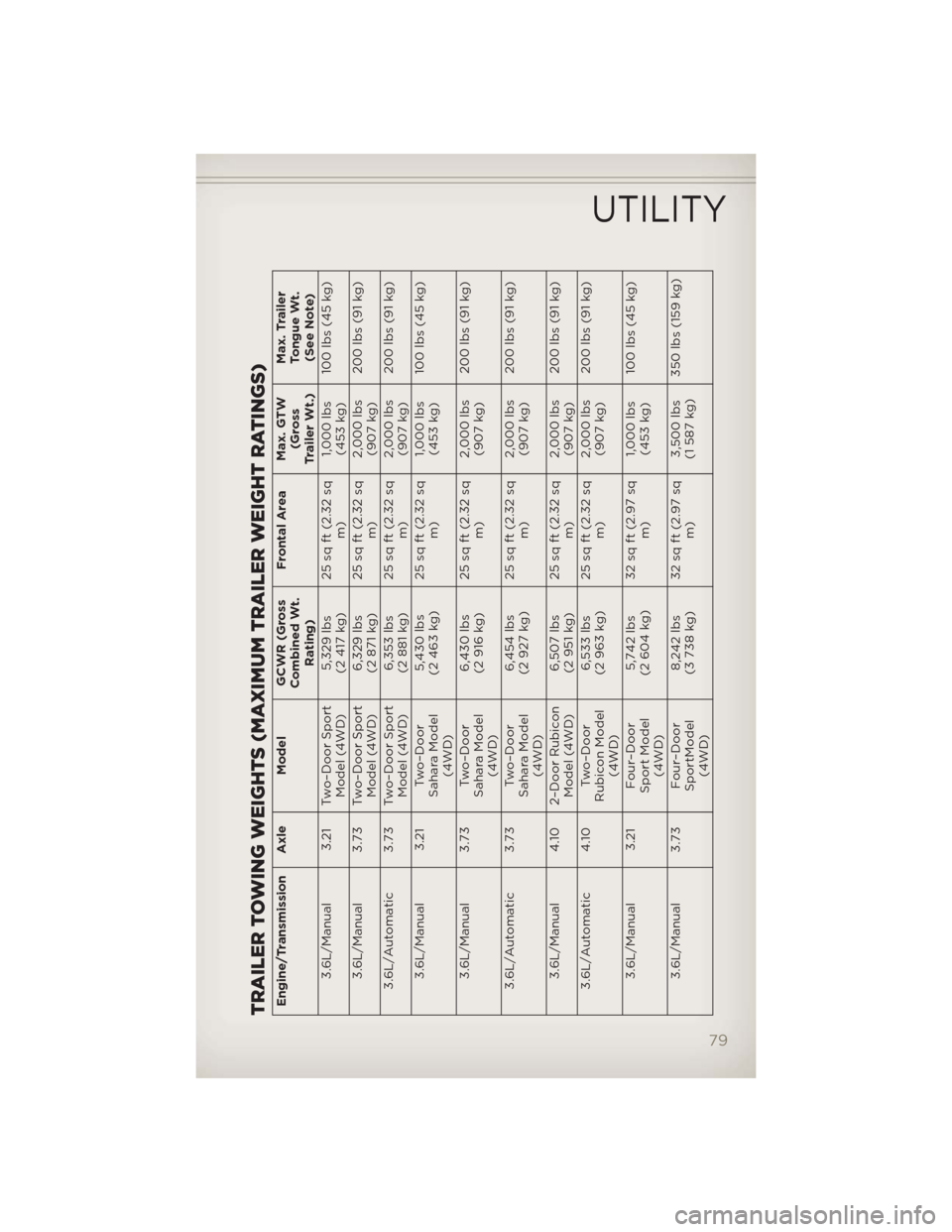
TRAILER TOWING WEIGHTS (MAXIMUM TRAILER WEIGHT RATINGS)Engine/Transmission Axle ModelGCWR (Gross
Combined Wt.
Rating)Frontal AreaMax. GTW
(Gross
Trailer Wt.)Max. Trailer
Tongue Wt.
(See Note)
3.6L/Manual 3.21 Two–Door Sport
Model (4WD)5,329 lbs
(2 417 kg)25 sq ft (2.32 sq
m)1,000 lbs
(453 kg)100 lbs (45 kg)
3.6L/Manual 3.73 Two–Door Sport
Model (4WD)6,329 lbs
(2 871 kg)25 sq ft (2.32 sq
m)2,000 lbs
(907 kg)200 lbs (91 kg)
3.6L/Automatic 3.73 Two–Door Sport
Model (4WD)6,353 lbs
(2 881 kg)25 sq ft (2.32 sq
m)2,000 lbs
(907 kg)200 lbs (91 kg)
3.6L/Manual 3.21 Two–Door
Sahara Model
(4WD)5,430 lbs
(2 463 kg)25 sq ft (2.32 sq
m)1,000 lbs
(453 kg)100 lbs (45 kg)
3.6L/Manual 3.73 Two–Door
Sahara Model
(4WD)6,430 lbs
(2 916 kg)25 sq ft (2.32 sq
m)2,000 lbs
(907 kg)200 lbs (91 kg)
3.6L/Automatic 3.73 Two–Door
Sahara Model
(4WD)6,454 lbs
(2 927 kg)25 sq ft (2.32 sq
m)2,000 lbs
(907 kg)200 lbs (91 kg)
3.6L/Manual 4.10 2–Door Rubicon
Model (4WD)6,507 lbs
(2 951 kg)25 sq ft (2.32 sq
m)2,000 lbs
(907 kg)200 lbs (91 kg)
3.6L/Automatic 4.10 Two–Door
Rubicon Model
(4WD)6,533 lbs
(2 963 kg)25 sq ft (2.32 sq
m)2,000 lbs
(907 kg)200 lbs (91 kg)
3.6L/Manual 3.21 Four–Door
Sport Model
(4WD)5,742 lbs
(2 604 kg)32 sq ft (2.97 sq
m)1,000 lbs
(453 kg)100 lbs (45 kg)
3.6L/Manual 3.73 Four–Door
SportModel
(4WD)8,242 lbs
(3 738 kg)32 sq ft (2.97 sq
m)3,500 lbs
(1 587 kg)350 lbs (159 kg)
UTILITY
79
Page 82 of 124
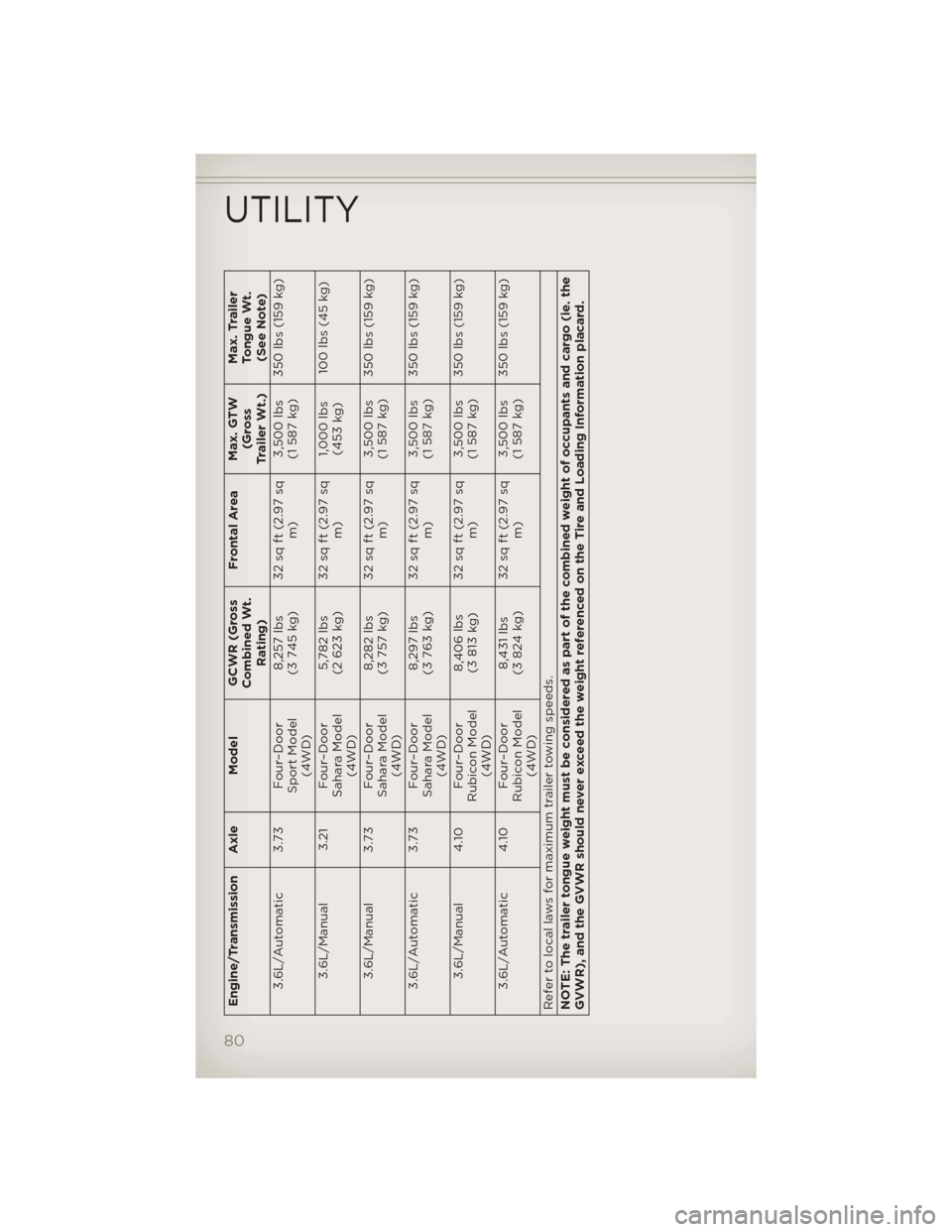
Engine/Transmission Axle ModelGCWR (Gross
Combined Wt.
Rating)Frontal AreaMax. GTW
(Gross
Trailer Wt.)Max. Trailer
Tongue Wt.
(See Note)
3.6L/Automatic 3.73 Four–Door
Sport Model
(4WD)8,257 lbs
(3 745 kg)32 sq ft (2.97 sq
m)3,500 lbs
(1 587 kg)350 lbs (159 kg)
3.6L/Manual 3.21 Four–Door
Sahara Model
(4WD)5,782 lbs
(2 623 kg)32 sq ft (2.97 sq
m)1,000 lbs
(453 kg)100 lbs (45 kg)
3.6L/Manual 3.73 Four–Door
Sahara Model
(4WD)8,282 lbs
(3 757 kg)32 sq ft (2.97 sq
m)3,500 lbs
(1 587 kg)350 lbs (159 kg)
3.6L/Automatic 3.73 Four–Door
Sahara Model
(4WD)8,297 lbs
(3 763 kg)32 sq ft (2.97 sq
m)3,500 lbs
(1 587 kg)350 lbs (159 kg)
3.6L/Manual 4.10 Four–Door
Rubicon Model
(4WD)8,406 lbs
(3 813 kg)32 sq ft (2.97 sq
m)3,500 lbs
(1 587 kg)350 lbs (159 kg)
3.6L/Automatic 4.10 Four–Door
Rubicon Model
(4WD)8,431 lbs
(3 824 kg)32 sq ft (2.97 sq
m)3,500 lbs
(1 587 kg)350 lbs (159 kg)
Refer to local laws for maximum trailer towing speeds.
NOTE: The trailer tongue weight must be considered as part of the combined weight of occupants and cargo (ie. the
GVWR), and the GVWR should never exceed the weight referenced on the Tire and Loading Information placard.
UTILITY
80
Page 83 of 124
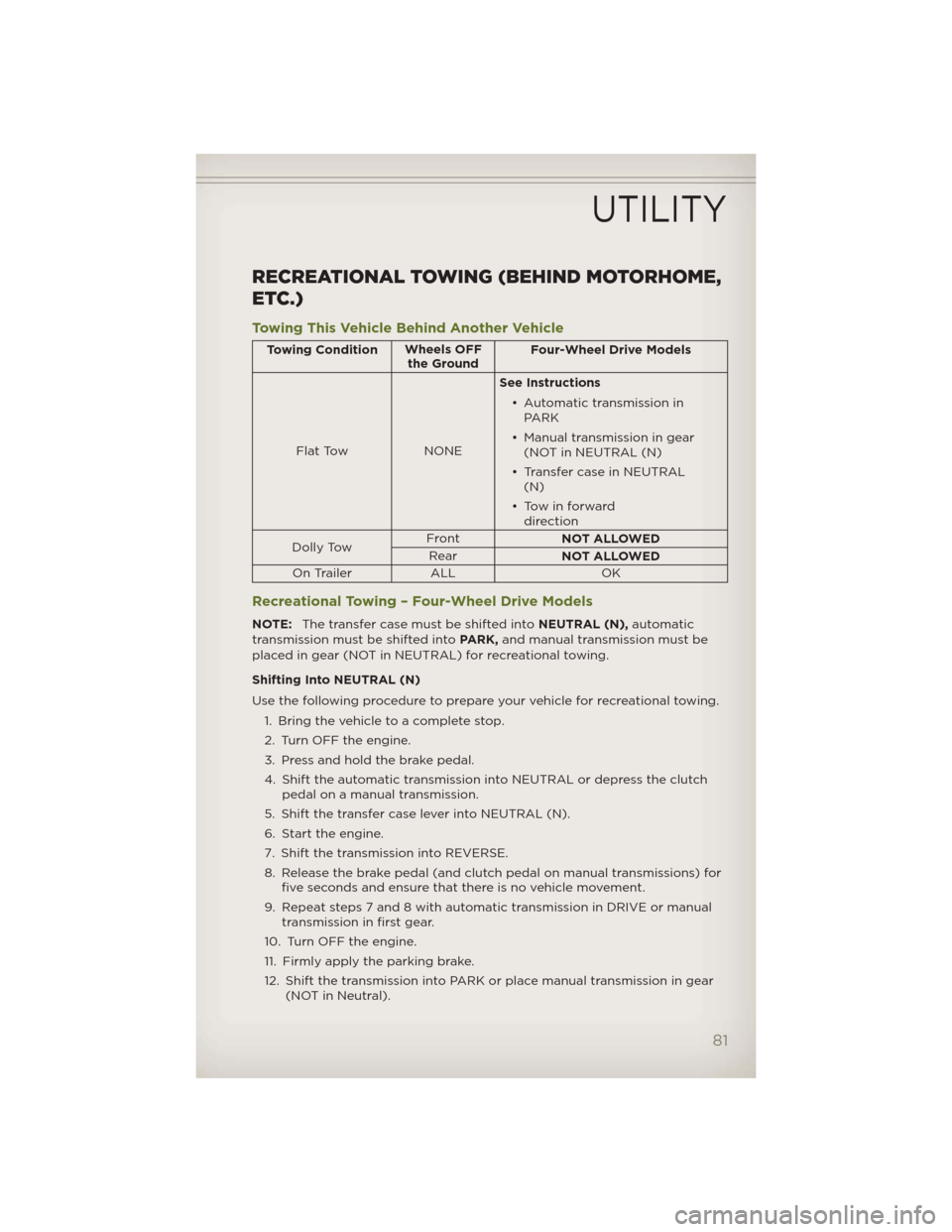
RECREATIONAL TOWING (BEHIND MOTORHOME,
ETC.)
Towing This Vehicle Behind Another Vehicle
Towing ConditionWheels OFF
the GroundFour-Wheel Drive Models
Flat Tow NONESee Instructions
• Automatic transmission in
PARK
• Manual transmission in gear
(NOT in NEUTRAL (N)
• Transfer case in NEUTRAL
(N)
• Tow in forward
direction
Dolly TowFront
NOT ALLOWED
Rear
NOT ALLOWED
On Trailer ALL OK
Recreational Towing – Four-Wheel Drive Models
NOTE:The transfer case must be shifted intoNEUTRAL (N),automatic
transmission must be shifted intoPARK,and manual transmission must be
placed in gear (NOT in NEUTRAL) for recreational towing.
Shifting Into NEUTRAL (N)
Use the following procedure to prepare your vehicle for recreational towing.
1. Bring the vehicle to a complete stop.
2. Turn OFF the engine.
3. Press and hold the brake pedal.
4. Shift the automatic transmission into NEUTRAL or depress the clutch
pedal on a manual transmission.
5. Shift the transfer case lever into NEUTRAL (N).
6. Start the engine.
7. Shift the transmission into REVERSE.
8. Release the brake pedal (and clutch pedal on manual transmissions) for
five seconds and ensure that there is no vehicle movement.
9. Repeat steps 7 and 8 with automatic transmission in DRIVE or manual
transmission in first gear.
10. Turn OFF the engine.
11. Firmly apply the parking brake.
12. Shift the transmission into PARK or place manual transmission in gear
(NOT in Neutral).
UTILITY
81
Page 84 of 124
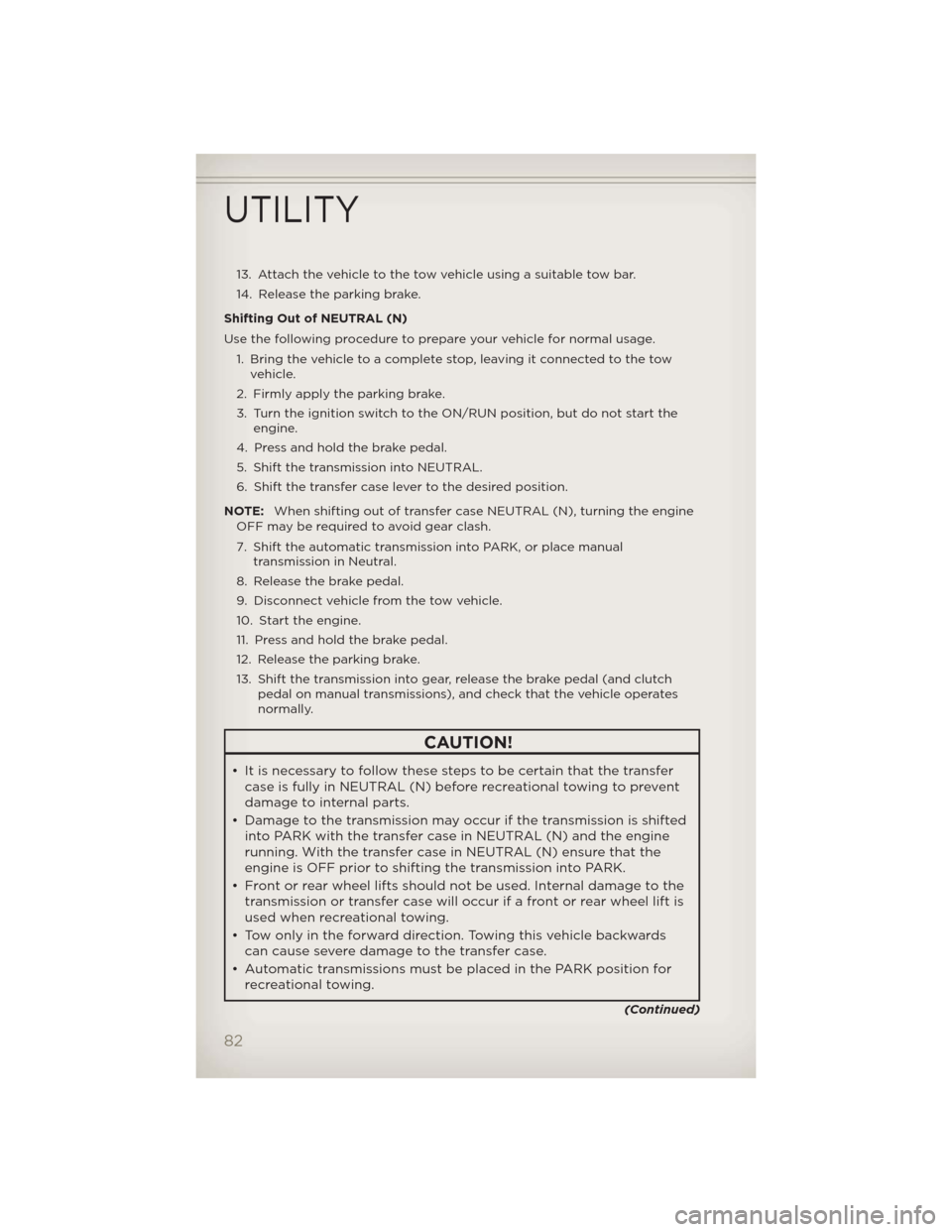
13. Attach the vehicle to the tow vehicle using a suitable tow bar.
14. Release the parking brake.
Shifting Out of NEUTRAL (N)
Use the following procedure to prepare your vehicle for normal usage.
1. Bring the vehicle to a complete stop, leaving it connected to the tow
vehicle.
2. Firmly apply the parking brake.
3. Turn the ignition switch to the ON/RUN position, but do not start the
engine.
4. Press and hold the brake pedal.
5. Shift the transmission into NEUTRAL.
6. Shift the transfer case lever to the desired position.
NOTE:When shifting out of transfer case NEUTRAL (N), turning the engine
OFF may be required to avoid gear clash.
7. Shift the automatic transmission into PARK, or place manual
transmission in Neutral.
8. Release the brake pedal.
9. Disconnect vehicle from the tow vehicle.
10. Start the engine.
11. Press and hold the brake pedal.
12. Release the parking brake.
13. Shift the transmission into gear, release the brake pedal (and clutch
pedal on manual transmissions), and check that the vehicle operates
normally.
CAUTION!
• It is necessary to follow these steps to be certain that the transfer
case is fully in NEUTRAL (N) before recreational towing to prevent
damage to internal parts.
• Damage to the transmission may occur if the transmission is shifted
into PARK with the transfer case in NEUTRAL (N) and the engine
running. With the transfer case in NEUTRAL (N) ensure that the
engine is OFF prior to shifting the transmission into PARK.
• Front or rear wheel lifts should not be used. Internal damage to the
transmission or transfer case will occur if a front or rear wheel lift is
used when recreational towing.
• Tow only in the forward direction. Towing this vehicle backwards
can cause severe damage to the transfer case.
• Automatic transmissions must be placed in the PARK position for
recreational towing.
(Continued)
UTILITY
82